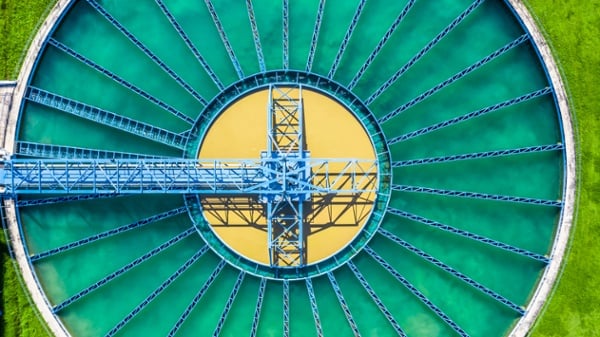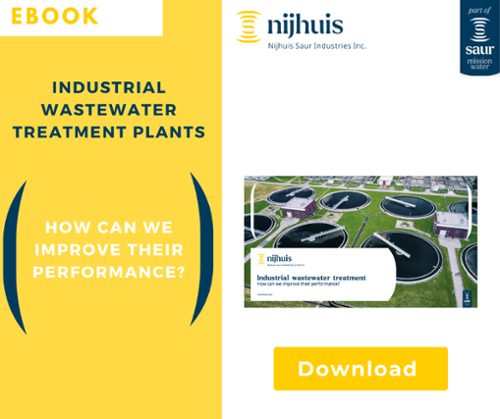In industry today, the image projected by CSR and performance standards is central to all development projects. Once considered as inevitable fixed cost centers with little room for achieving financial savings, industrial wastewater treatment plants are no longer exempt from this trend. Here are the Top 5 key indicators you should monitor to assess their effectiveness:
- Regulatory compliance
- Inflow load
- The quantity of waste produced
- Operating costs
- Recovery

1. Regulatory compliance
Process wastewater, production residues and cleaning/disinfection products: the prime purpose of an industrial wastewater treatment plant is still to treat discharges from the production unit it serves in order to avoid polluting the environment generally, and the immediate area of discharge in particular.
So if there is one performance indicator that must be monitored accurately and at all times, it is regulatory compliance. All manufacturers must comply with the regulatory discharge standards (as defined by prefectoral order in France). Central and local government monitor compliance very closely. Regardless of circumstances, any failure to meet the thresholds set is penalized by a pollution fine, which has the potential to be very high. In the worst cases, it can lead to the issue of a formal notice of compliance, or even a temporary site shutdown order, both of which can be catastrophic financially and in terms of company image and reputation.
2. Inflow load
To ensure regulatory compliance, the inflow load entering the industrial water treatment plant must be closely monitored, because every unit has a finite treatment capacity. So if the inflow load drifts too high, the outflow load may hover around, or even exceed, discharge standards.
Over and above the problems this may pose for the authorities, there is a major risk to the public image of the company, which could be seriously compromised. This is especially true in today’s world, where such negative publicity can quickly go viral, especially via social media.
Monitoring the inflow load also enables the raw material losses of the plant to be measured. This is an important performance indicator for site managers, because any loss of raw materials increases not only production costs, but also plant operating costs.
When the pollutant load entering an industrial wastewater treatment plant intensifies, it inevitably increases plant operating costs in general, but especially those related to electricity consumption, treatment reagents, residual sludge production and supervising personnel, all of which in turn result in higher overall production costs for the company. Although experts are working on the issue of energy efficiency, the aeration turbines essential for correct plant operation can still account for up to 40% of industrial wastewater treatment plant operating costs.

3. The quantity of waste produced
The quantity of waste produced by an industrial wastewater treatment plant also depends on the level of pollution entering the plant. Unless this waste is redirected to an appropriate recovery channel for reuse, it represents an additional cost for the industrial user concerned, which therefore has every interest in limiting that cost. There are 3 options for achieving this:
- Taking direct action to modify the factory's manufacturing processes to reduce pollution at source by implementing best practices and efficient management at every stage of the production process
- Opting for treatment processes that reduce waste: these include methanization, which limits the production of residual sludge, at the same time as generating producing recoverable energy, or even by using innovative sludge dewatering technologies that significantly reduce the physical volume of residual sludge
- Seeking out new channels for recovery and reuse: since spreading residual sludge on agricultural land is likely to be prohibited at some point in the future, it will be essential for manufacturers to use new channels (e.g. sludge composting or on-site/local methanization)
4. Operating costs
For industrial users, wastewater treatment plant operating costs are naturally a key performance indicator. As previously mentioned, there are multiple parameters that need to be monitored if these costs are to be controlled:
- management of the plant by the operating teams (servicing, maintenance, analysis, residual sludge management, regulatory monitoring, relationships with the relevant authorities, reporting, etc.) and optimization of the time spent on these tasks
- energy consumption
- the treatment reagents used
- the waste produced
5. Recovery
In this scenario, the wastewater treatment plant is no longer a cost center, but rather a production center integral to plant operation.
Options for reusing treated wastewater are currently being researched. Channels for the recovery of wastewater treatment byproducts already exist and are in operation. The recovery of methanization-generated biogas is already widely used across industry for internal use as a fuel, or for injection into the public gas supply system.
It is the responsibility of the operator to focus all its skills and expertise (from the design and construction stage, where possible) to add value to the industrial wastewater treatment plant and to make it possible for its own operations staff to run the plant at maximum performance.
Want to know more?
Take a look at our eBook guide on this subject or e-mail us at: saur.industrie@saur.com



